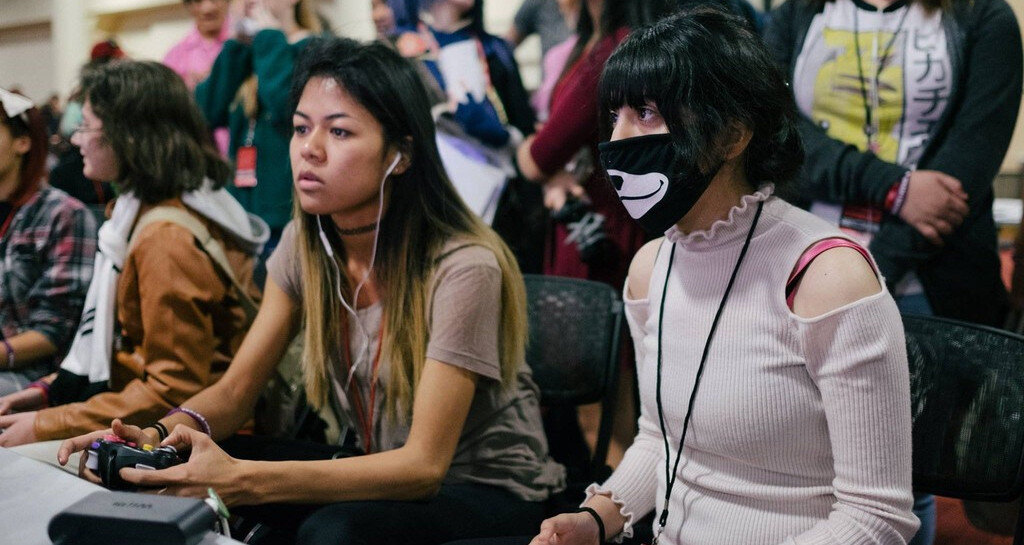OPTIONAL THEME: KNOWLEDGE AND TECHNOLOGY
VIDEO GAMING: DISTRACTION OR MEDICINE?
Image credit: Smash Sisters
Video gaming is a growing global subculture. An exploration of the Knowledge and Technology theme would be incomplete without inviting students to reflect on their own relationship to gaming. Indeed some students in the class may have “built their own PC” in order to optimize graphic resolution for their favorite video games.
This unit does not dwell on the negative aspects of video gaming much hyped in popular media. The research on this topic is often inconclusive and contradictory, even when correlation is established, causation can remain problematic.
In the spirit of the core theme—Knowledge and the Knower—we begin with brain plasticity and our propensity to seek distraction. We follow this with two intriguing developments—the first FDA approved video game prescription; and global esports.
CLASS ACTIVITY I:
EPISTEMIC HUNGER—WE ARE information
seeking CREATURES
Invite the class to arrange themselves into groups of three. They are about to consider, in the intimacy of their group, how digital technology innovations may be impacting their thinking. As background stimulus reading, before they respond to the generative questions, each person in the trio will read aloud to the rest of the group, one of the paragraphs from Adam Gazzaley and Larry Rosen’s recent book, The Distracted Mind.
““Multitasking” [is] defined as the act of attempting to engage simultaneously in two or more tasks that have independent goals. The word “attempting” is used here because… multitasking is the behavior you decide to engage in, but when it comes to what actually occurs in your brain, the term “task switching” is a better description...
Novelty is associated with reward processing in our brains. This is not surprising as novelty seeking is a powerful force to explore new environments, and this offers clear survival advantages. The novelty load is undoubtedly higher when frequently switching between new tasks than when just staying put, so it is logical that the overall reward gains, and thus the fun factor as well, are heightened when multitasking...
Humans seem to exhibit an innate drive to forage for information in much the same way that other animals are driven to forage for food, we need to consider how this ‘hunger’ is now fed to an extreme degree by modern technological advances that deliver highly accessible information.”
”
Allow six timed minutes for exploration and discussion of the generative questions, and provide a one minute warning. Tell students in advance that one appointed spokesperson will report back—with the understanding that there will be a protocol of partial confidentiality. For example they might say “one of us mentioned” rather than pinpointing an individual. Pdf. of the paragraphs and questions.
GENERATIVE QUESTIONS
1. When doing homework or on social media with friends how many windows or apps do you tend to have open at once?
2. Be specific—what is your own experience with multitasking?
3. How often do you find yourself being distracted by screens because in the moment it seems more interesting than schoolwork; hanging out with friends or loved ones; or getting out to participating in sports or exercising?
REWIRING THE BRAIN
Next, lay the groundwork for the next activities by showing this amusing short video about ongoing brain plasticity in response to lived experience. The consequences for learning and selfhood are enormous, and certainly include subtle changes to the wet-wiring of our brains in response to sustained interactions with digital technology.
Remind students that digital technology extends our phenotype (biological body). This concept was previously encountered in the 41 orders of magnitude unit in Knowledge and the Knower, the core theme.
CLASS ACTIVITY II:
AN ENCOUNTER WITH ENDEAVOR.RX
Without initially revealing the EndeavorRx theme, begin the class by surveying the students’ relationship to video gaming. Solicit a show of hands in response to each of the questions below. Tally the responses rapidly on the whiteboard.
Alternatively you could place the survey questions in a Google Form and display the class results in the piecharts that are generated automatically.
VIDEO GAMING SURVEY QUESTIONS
Raise your hand if you…
… currently play video games at least once a week
…played creative video games like Minecraft when you were younger
…have ever played a combat video game where blood is visible in the graphics
…know what esports are
…have been an audience member of esports—online or at a live event
FREe RESPONSE QUESTION
What are the necessary skills and lifestyle habits for the best video game players?
After capturing thoughts generated by the free response question on the whiteboard; show the first of the EndeavorRX videos without further editorial.
Solicit student responses immediately afterwards. You may or may not need the suggested generative question.
GENERATIVE QUESTIONS
Based on the short video clip, how would you rate
the EndeavorRx video game? Justify your response.
Finally it is time for the full reveal. Show the second video. Emphasize the impeccable credentials of the Neuroscape research group at UCSF; but avoid any further Socratic steering of the conversation. Simply ask students for their thoughts in response to what they see.
CLASS ACTIVITY III:
ESPORTS
Provide some context for an esports conversation by revisiting the Games and sports class activity from the Knowledge and language optional theme. Dive right in with the following controversial question:
Is the traditional Spanish bullfight a game or a sport? If you think it something else entirely—what is it?
Bullring in Sevilla, Spain
Photo: Yadid Levi/Getty Images
BECOMING A DOTA 2 AFICIONADO
In LESS THAN 15 MINUTES
Next allow students to briefly immerse themselves in a single, world famous video game as a case study. Allow students time to work through the five sources individually. Then divide the class into two geographically separated, out-of-earshot, discussion circles to tackle the generative questions.
It is likely that a few students will have read the teen-friendly, science fiction novel, Ender's Game, written by Orson Scott Card in 1985. The movie trailer is included at the very end. Its relevance to the generative questions is not obscure.
SOURCE #1
DOTA 2 a global multiplayer video game that is played with two teams of five players—each of the ten players independently controlling a hero character who has distinct attributes and a unique playing style. This first video source introduces the original DOTA (Defense Of The Ancients) game, before its spectacular upgrade to DOTA 2.
SOURCE #2
This second video was created in China using the Source Filmmaker (SFM) movie-making tool—that allows the user to craft movies inside a specific game engine. This video illustrates the enhanced graphics and greater sophistication of the DOTA 2 sequel. The movie soundtrack features commentary in Mandarin and English from The International (TI) world championship DOTA 2 tournament.
SOURCE #3
This photo conveys the scale and production values of the 2014 Dota 2 International championship hosted in The KeyArena in Seattle. There were 10,000 fans in attendance and almost $11 million in prize money.
Photo source: © DOTA 2
SOURCE #4
This video outlines the latest refinements to the DOTA Pro Circuit (DPC). The need for increased stratification is a response to the increased popularity of esports generally, and DOTA 2 in particular. The imagery in the video includes glimpses of fired up TI championship teams.
SOURCE #5
The final source is the official DOTA 2 website for those who would like to delve a notch deeper before wrestling with these questions.
GENERATIVE QUESTIONS
1. So, are esports games, sports, or something else entirely?
2. Esports are currently being considered for inclusion in the Olympic Games—what is your own perspective on the validity of this proposal?
3. What are some of the fundamental differences between games like DOTA 2 and more explicitly violent games like Grand Theft Auto, Red Dead Redemption, and Call of Duty?
4. What are some of the emergent ethical concerns that come to mind as a consequence of increased global participation in video gaming and esports?
5. To what extent do the skills required for video gaming, piloting fighter jets and controlling military drones overlap?
“The fighter jet era has passed… drone warfare is where the future will be.”


